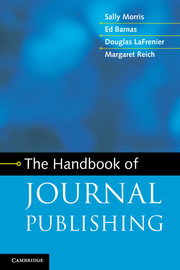Book contents
- Frontmatter
- Contents
- Preface and acknowledgments
- 1 Introduction to journals
- 2 Managing journals
- 3 Editing
- 4 The production process
- 5 Journal metrics
- 6 Marketing and sales
- 7 Fulfillment
- 8 Journal finances
- 9 Subsidiary income
- 10 Contract publishing
- 11 Copyright and other legal aspects
- 12 Ethical issues
- 13 The future of scholarly communication
- Appendix 1 Glossary
- Appendix 2 Resources
- Appendix 3 Vendors
- Index
- References
4 - The production process
Published online by Cambridge University Press: 05 March 2013
- Frontmatter
- Contents
- Preface and acknowledgments
- 1 Introduction to journals
- 2 Managing journals
- 3 Editing
- 4 The production process
- 5 Journal metrics
- 6 Marketing and sales
- 7 Fulfillment
- 8 Journal finances
- 9 Subsidiary income
- 10 Contract publishing
- 11 Copyright and other legal aspects
- 12 Ethical issues
- 13 The future of scholarly communication
- Appendix 1 Glossary
- Appendix 2 Resources
- Appendix 3 Vendors
- Index
- References
Summary
When manuscripts were submitted on paper, mailed in envelopes with postage, and edited with color pencils, production started after a manuscript was accepted for publication, and the term “production” is still used for that stage of manuscript processing. However, with the use of electronic files, the preparation of the manuscript and related figures, datasets, etc., for publication starts long before its acceptance, so that it makes sense to combine discussion of peer-review systems and production processes. As authors are asked to prepare their manuscripts for electronic submission in ways that will make the production process more efficient, we will start our discussion of production with an overview of electronic submission and peer-review systems.
Electronic submission and peer-review systems
With the development of electronic technology for preparing manuscripts, authors went first from mailing typescripts to journal Editorial offices to mailing disks they had prepared using word-processing programs, and then to not using the mail at all when it became possible to attach article and figure files to emails or to send them using file transfer protocol (FTP).
In the late 1990s, web-based submission and peer-review systems were developed (Hames, 2007; Tananbaum and Holmes, 2008) that allowed everyone (journal Editors, reviewers, authors, assistants) involved in peer review to access, from anywhere in the world, a site on the web that allowed them to deal with a manuscript, rather than sending it to someone or waiting to receive it. This saved both time – especially time waiting for manuscripts and reviews to arrive in the mail – and money – specifically in copying, faxing, mailing, and telephone costs. In many cases, savings were realized in staff costs as well, as there was no longer a need for staff to open mail, log in paper submissions, count pages, make copies, mail manuscripts to journal Editors and reviewers, and so on.
- Type
- Chapter
- Information
- The Handbook of Journal Publishing , pp. 104 - 132Publisher: Cambridge University PressPrint publication year: 2013
References
- 1
- Cited by

